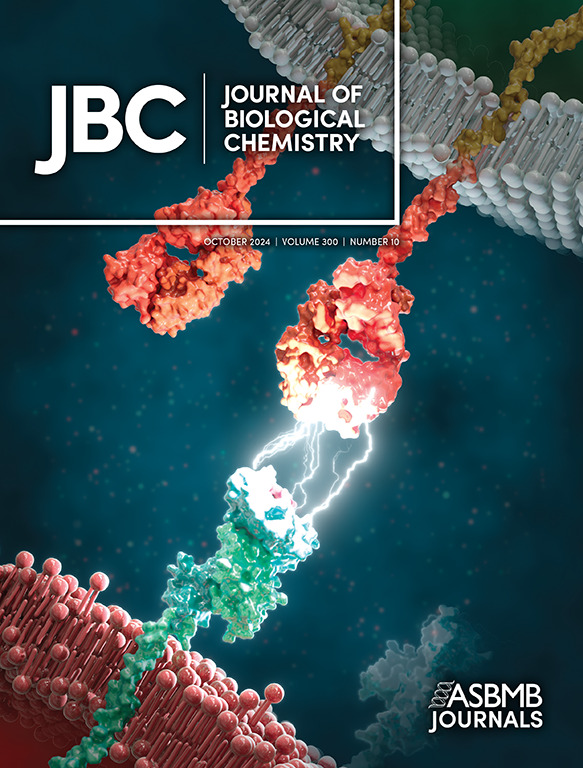FAK活性通过VEGFR2-CBL-NF-κB信号加剧了紊乱的血流介导的动脉粥样硬化
IF 4
2区 生物学
Q2 BIOCHEMISTRY & MOLECULAR BIOLOGY
引用次数: 0
摘要
动脉粥样硬化在脉管系统中可预测的部位发展,分支点和曲率产生非层流紊乱。这种紊乱的血流通过增加内皮细胞(EC)屏障渗透性和炎症基因(如血管细胞粘附分子-1 (VCAM-1))的表达而引起血管炎症。血管内皮生长因子受体2 (VEGFR2)调控血流诱导的EC炎症;然而,在了解其确切的信号机制或途径方面仍有一些空白。局灶黏附激酶(FAK)是一种酪氨酸蛋白激酶,其表达与内皮细胞中血流介导的信号传导有关。然而,FAK和VEGFR2在血流介导的炎症信号传导中的联系尚不清楚。在这里,我们发现用VEGF启动VEGFR2对于FAK和NF-kB的流动介导激活至关重要。机制上,FAK激活触发Casitas b系淋巴瘤(CBL;一种E3泛素连接酶)在流动条件下与VEGFR2相互作用。然而,FAK抑制减少了VEGFR2-FAK- cbl复合物的形成,部分原因是细胞膜上VEGFR2的表达减少。此外,喂食西方饮食(WD)的Apoe-/-小鼠在主动脉弓内动脉粥样硬化干扰血流区域的FAK活性比外弓高。血流紊乱诱导的FAK激活与主动脉弓内侧内皮细胞表面VEGFR2升高有关,但与外弓无关。综上所述,这些数据表明,在血流紊乱的情况下,抑制FAK活性的增强可能有助于减少内皮层的促炎信号。本文章由计算机程序翻译,如有差异,请以英文原文为准。
FAK activity exacerbates disturbed flow-mediated atherosclerosis via VEGFR2-CBL-NF-κB signaling
Atherosclerosis develops at predictable sites in the vasculature where branch points and curvatures create non-laminar disturbed flow. This disturbed flow causes vascular inflammation by increased endothelial cell (EC) barrier permeability and the expression of inflammatory genes such as vascular cell adhesion molecule-1 (VCAM-1). Vascular endothelial growth factor receptor 2 (VEGFR2) regulates flow-induced EC inflammation; however, there are still some gaps in understanding the precise signaling mechanism or pathway. Focal adhesion kinase (FAK) is a protein tyrosine kinase whose expression has been implicated in flow-mediated signaling in ECs. However, the link between FAK and VEGFR2 in flow-mediated inflammation signaling has remained unelucidated. Here we found that priming of VEGFR2 with VEGF was critical for flow-mediated activation of FAK and NF-kB. Mechanistically, FAK activation triggers tyrosine phosphorylation of Casitas B-lineage lymphoma (CBL; an E3 ubiquitin ligase) that interacts with VEGFR2 under flow conditions. However, FAK inhibition reduced VEGFR2-FAK-CBL complex formation, partly due to reduced expression of VEGFR2 on the cell membrane. Further, Apoe-/- mice fed a western diet (WD) exhibited increased FAK activity within the atheroprone disturbed flow region of the inner aortic arch compared to the outer arch. Disturbed flow-induced FAK activation is associated with elevated VEGFR2 on the surface of ECs of the inner aortic arch, but not in the outer arch. Taken together, these data suggest that suppression of augmented FAK activity under disturbed flow may prove beneficial in reducing pro-inflammatory signaling of the endothelial layer.
求助全文
通过发布文献求助,成功后即可免费获取论文全文。
去求助
来源期刊

Journal of Biological Chemistry
Biochemistry, Genetics and Molecular Biology-Biochemistry
自引率
4.20%
发文量
1233
期刊介绍:
The Journal of Biological Chemistry welcomes high-quality science that seeks to elucidate the molecular and cellular basis of biological processes. Papers published in JBC can therefore fall under the umbrellas of not only biological chemistry, chemical biology, or biochemistry, but also allied disciplines such as biophysics, systems biology, RNA biology, immunology, microbiology, neurobiology, epigenetics, computational biology, ’omics, and many more. The outcome of our focus on papers that contribute novel and important mechanistic insights, rather than on a particular topic area, is that JBC is truly a melting pot for scientists across disciplines. In addition, JBC welcomes papers that describe methods that will help scientists push their biochemical inquiries forward and resources that will be of use to the research community.
 求助内容:
求助内容: 应助结果提醒方式:
应助结果提醒方式:


